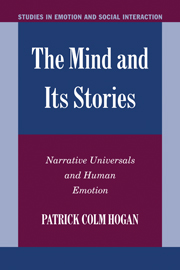Book contents
- Frontmatter
- Contents
- Acknowledgments
- The Mind and Its Stories
- Introduction: Studying Narrative, Studying Emotion
- 1 Literary Universals
- 2 Emotion and Suggestion: Lexical Processes in Literary Experience
- 3 Four Hypotheses on Emotion and Narrative
- 4 Writing Beyond the Ending: A Problem of Narrative, Empathy, and Ethics
- 5 Extending the Theory: Emotion Prototypes, Narrative Junctures, and Lyric Poetry
- 6 Testing, Revision, and the Program of Research in Narrative Universals: Ainu Epic and the Plot of Sacrifice
- 7 The Structure of Stories: Some General Principles of Plot
- Afterword: From the Emotional Nature of Narrative to the Narrative Nature of Emotion
- Works Cited
- Index
- Titles in the series
Afterword: From the Emotional Nature of Narrative to the Narrative Nature of Emotion
Published online by Cambridge University Press: 11 July 2009
- Frontmatter
- Contents
- Acknowledgments
- The Mind and Its Stories
- Introduction: Studying Narrative, Studying Emotion
- 1 Literary Universals
- 2 Emotion and Suggestion: Lexical Processes in Literary Experience
- 3 Four Hypotheses on Emotion and Narrative
- 4 Writing Beyond the Ending: A Problem of Narrative, Empathy, and Ethics
- 5 Extending the Theory: Emotion Prototypes, Narrative Junctures, and Lyric Poetry
- 6 Testing, Revision, and the Program of Research in Narrative Universals: Ainu Epic and the Plot of Sacrifice
- 7 The Structure of Stories: Some General Principles of Plot
- Afterword: From the Emotional Nature of Narrative to the Narrative Nature of Emotion
- Works Cited
- Index
- Titles in the series
Summary
Up to now, we have treated emotion fairly narrowly, focusing in particular on emotion prototypes as generative of stories, though also treating emotive response to literature. In these final pages, I should like to consider emotion itself, outside literature. Specifically, I should like to reverse the direction of study and examine the ways in which emotion is a function of narrative – not emotion in literary response, but emotion as we experience and understand it in ordinary life. First, I shall discuss some of the ways in which the eliciting conditions, actional outcomes, and even phenomenological tone of emotions are shaped and oriented by stories and lexical prototypes. In connection with this, I shall touch on some political consequences and ideological functions of prototypical narratives in their various social specifications. Second, I shall consider the biological givens of emotion, just how these are reshaped socially, and how both the biological and social components relate to narrative, including the prototypical narratives we have been considering.
CONVENTION, FEELING, AND SOCIAL FUNCTION
Our ordinary view of emotions is that they preexist prototypes and stories. Our lexical items name them. Our stories recount and, when successful, trigger them. In part, this is no doubt true. It is simply a pattern of nature that people run from packs of wolves, scream, contort their facial features in certain ways, and so on. In other words, in part our prototype for “fear” simply captures a natural phenomenon. But there is more to it than that.
- Type
- Chapter
- Information
- The Mind and its StoriesNarrative Universals and Human Emotion, pp. 239 - 264Publisher: Cambridge University PressPrint publication year: 2003



